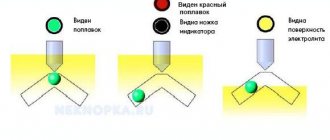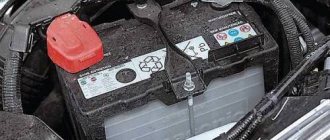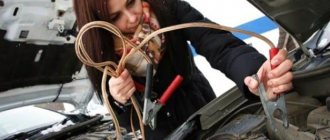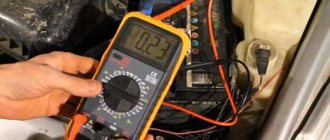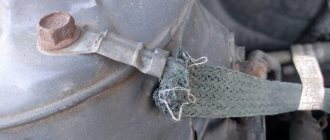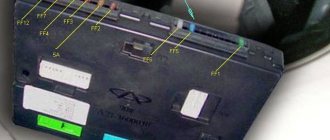Many car owners are faced with a situation where, according to reviews, a good battery lasts much less than the period stated by the manufacturer. The search for possible causes often turns out to be fruitless; the opinion of experts is that it is better to simply throw away such a battery and replace it with a new one.
But do not rush to blindly follow such advice. If the battery does not want to accept a charge, you can try to teach it to do so by performing a special training called CTC.
What is KTC
A classic acid battery has a limited resource - the ability of the plates to hold a charge inevitably decreases over time, which is the main reason for the battery’s premature failure to start the engine.
This is also facilitated by the prevailing operating conditions of the vehicle: urban driving with frequent trips over short distances, living in a region with a cold climate.
All these factors, as well as ignoring timely battery maintenance, affect the life of the battery. But even under ideal conditions, it often happens that the battery still lasts much less than the stated life.
A special procedure called the battery control-training cycle helps to prolong it; the recommended frequency of its implementation is every six months. This kind of training can really work wonders.
CTC is carried out to restore batteries that have been completely discharged or have been in use for a long time. Thanks to this cycle, it becomes possible to improve and partially restore the battery's lost ability to accumulate and hold a charge.
To carry out the procedure yourself, you will need a hydrometer (to measure the density of the electrolyte), a multimeter and an electrical load with specific parameters.
To train or not to train batteries
Hello! The article, in my opinion, is quite chaotic, generally stupid for both the “experienced” and the “ordinary” user. The first category (I mean those who are ready to seriously understand the issue) will receive a bunch of facts, some of which are undoubtedly true, but some are just “legends about dinosaurs” that have little in common with modern batteries. For the average user, the most useful advice would probably be - buy a good charger and forget about everything that is written here. An explanation of what a good charger is can be reduced to a set of keywords on the box (-dV/dt, separate charging of each battery, battery testing, reverse polarity and temperature protection, “anti-battery” protection, etc.), the name of the manufacturer high-quality chargers and a couple of specific models to choose from.
It is interesting that the author does not hesitate to write phrases like: “...there are rumors that using a very high charging current you can charge the battery up to 200% of the declared capacity. Personally, I doubt it." I believe that just from this phrase one can already draw a conclusion about the author’s competence. I agree that so much nonsense has been written about batteries that you can’t figure it out without half a liter, but why repeat this again in the article? If you’ve already started writing advice, it would be good to check and not write “it’s better to do this, but there are rumors that.”
Again, a funny division into “seasoned” companies and simpler companies. Did the author do his own research on this? Just in case, I’ll say that batteries are used not only in notebooks, mobile phones, flashlights and cameras. There are many other applications, such as high-power radios or radio-controlled models. I can say that GP batteries are one of the best NiMH power batteries in the class 3000-4000 mAh, normal discharge currents are 20-40 Amps, I use them every training session in the Racing Club RC54 (). By the way, when we started playing with radio-controlled cars, the first thing we encountered was that a good charger for such batteries cost (and still costs!) good money (up to ~$200 for the charger and another ~$100 for the power source). We (I am a programmer, and my friend is an electronics engineer) after carefully studying the technology of charging NiCd, NiMH batteries - for this, in particular, we had to study in detail the chemistry of the charging process - we began to make chargers ourselves, and therefore I know firsthand what I’m talking about. There are probably a dozen people in the club now using our chargers - everyone is happy.
As usual, chemists manage to squeeze even more calories into the same form factor, i.e. At a constant volume, the capacity of the batteries increases. A capacity of 2500 mAh for AA batteries is already the norm. The declared 1000 recharge cycles, even taking into account careless handling on the part of the user, will last a long time, at least until the next new product is released. It seems that now any equipment, including batteries, becomes obsolete before it physically fails. I don’t know whether this in itself is good or bad, but it allows the “ordinary” user not to fill his head with unnecessary information.
As for LiIon batteries, due to some risk of ignition when overcharged or under high load, the vast majority of such batteries come with built-in electronic protection for both overcharge and overdischarge. Although the quality of such batteries is improving, after a couple of years a drop in capacity still becomes noticeable, no matter how carefully it is used, so don’t complicate your life, charge your phone or laptop when it’s convenient. (I suspect that sometimes quality is sacrificed for capacity - I remembered stories with self-igniting Dell laptops.)
Another similar type of battery, LiPo, is typically rarely used in consumer electronics and is both more expensive and more dangerous than LiIon. Their main advantage is simply gigantic discharge currents, with the same weight as NiMH they have a capacity approximately twice as high (or, which is the same thing, with the same capacity they have half the weight). Because of this, they are increasingly used in radio-controlled airplanes and helicopters. For example, on my RC plane I have a 2200 mAh battery weighing only 50 grams that produces up to 24 Amps! It is clear that, to make it easier, it comes without electronics, which, if handled carelessly, will not only damage the battery, but can also burn it - literally! — a house or car (pilots often charge batteries directly in the field from the car’s cigarette lighter). But! Modelers are certainly not ordinary users, therefore, in my opinion, this article is not relevant for them.
———— The comment turned out to be more than an article. Graphomania is a terrible disease!
